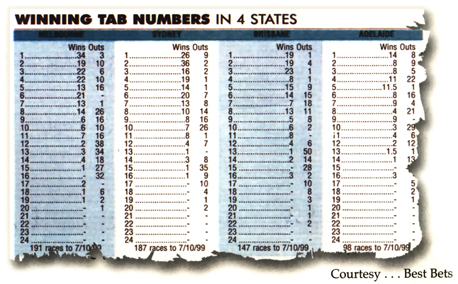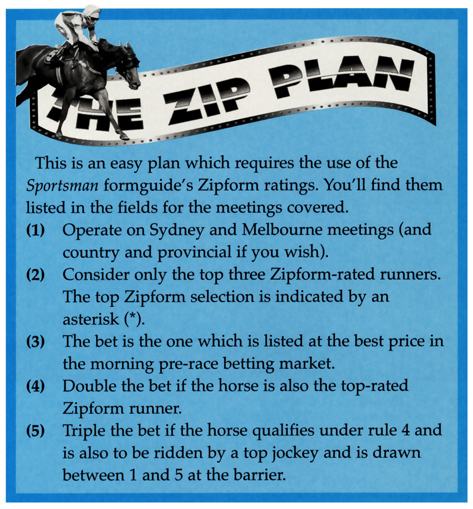Wouldn't it be nice if we could find a lovely "quick fix" for all our betting activity? A system with one rule, or just one direct "hit" into the form to produce winner after winner!
Nothing is as easy, as we all know. But, nevertheless, there are ways we can approach a race and, with the use of one or two simple rules, help ourselves to narrow down the chances.
For example, the first four TAB numbers (1, 2, 3, 4) win about 50 per cent of all races. Isn't this a great starting point for your form study? Rule off the first four, examine their form, and determine if they hold potent chances.
You KNOW that, overall, you will be looking at the winner 50 per cent of the time.
What about a way to find potential "true" favourites? Every punter would love to boost the average 30 per cent strike rate with favourites. What if it were possible to cut back the number of bets you have on the favourites without wrecking the win strike?
If you could chop out 20 false favourites, you'd be left with 80 bets, and if you could maintain the usual strike rate you'd be looking at 37.5 winners in those 80 bets, requiring an average price of only around 5 / 4 to get ahead of the game.
So, what's the way to go to find a short cut to slashing out the likely non-winning favourites? How about an insistence on the favourite being a last-start winner within the last 21 days?

That's not a bad start. Then demand that the horse have at least one other placing in its last three starts. Great. You're starting to look at a good bet.
Finally, why not demand that these races must have been at the same distance of the current race or within 100m either way?
If the horse qualifies, then there's your TRUE favourite. It's a horse with recent winning and placed form at the distance, or close to it, of the current race.
Did these rules ring a bell?
Maybe with readers who have been with us for some time, they did. They comprise the elements of the highly successful 50% Hotpots System, which we revealed in the very first issue of PPM back in April, 1985!
This system continues to perform wonderfully well. Just check the Punter's Choice racing consumer service. Ian Barns checks the system regularly and is always full of praise for it.
To me, the 50% Hotpots System is the ultimate "quick fix" approach for those punters who don't have the time, or the inclination, to pore over formlines for hours and hours.
Pittsburgh Phil and Chicago O'Brien had a simple yet highly effective approach to betting.
They looked for CERTAINTIES. They wanted to be sure the horse selected could be depended upon to win a bet for them in spite of all the things that could conceivably happen.
Phil used to say that all his work on form study usually would turn up possibly two bets.
So when you're seeking the "quick fix", don't try to get it on every race. That's simply too hard a task.
The following are 20 ideas to help you get the fix you need and come up with solid, rational selections.
- Consider only handicap races for open and welter class horses, and wfa races.
- Ignore all runners except those drawn in barriers 1, 2 and 3.
- No 1 wins a high proportion of races. Why not bet the No 1 horse in handicaps provided it ran within 2.5 lengths of the winner at its most recent start?
- For the occasional good eachway bet, bet any horse that has run 1st, 2nd or 3rd at each of its last five starts.
- In wfa races, choose the horse that has won or been placed at its latest three starts in wfa or set weights company, provided it is one of the top two favourites.
- Look for those runners with 100 per cent winning records at track or distance, provided there are two or more wins.
- ?Look for a horse that ran well second-up from a spell, finishing within 2.5 lengths of the winner. These horses often bob up and win at good odds at their third run back.
- If a horse has run 2nd last start, beaten less than a half length, and is now a hot favourite, then consider it a super bet. Double the bet if it's drawn between 1 and 5 at the barrier.
- Check out any runner who has won at least three times at track and distance and which is now one of the two top favourites following a win or placed run.
- Beware any horse that is up in weight and down in price on its last start. Look for these runners and strike them out. There will be little value in backing them longterm.
- Look at races of 1600m and further, and consider only those runners who have had their last race within 15 days and ran no worse than 3rd at their latest two runs. If more than one, bet all if possible, or bet the two at the best prices.

- Consider only those runners which come from the BEST stables.
- Zero in on CANBERRA trained runners at the four Sydney city tracks.
- Zero in on any Tasmanian horse racing at any of the four Melbourne city tracks. Don't worry about the price; bigger the better.
- Consider only the horses on the first four lines of the betting market and then eliminate any which are not ridden by a top jockey.
- Check the strike rates of trainers at the current track and consider those runners trained by the two trainers with the best strike rates.
- Bet any pre-race favourite who is carrying the lowest handicapped weight in the race. Many good priced favourites win when they are down in the handicap. Back them eachway.
- Consider only races with 11 or fewer runners. They are easier to handicap.
- Strike out any runner which did not win or finish within 3 lengths of the winner last start.
- Consider only the top two horses in the newspaper tipsters' poll and back the one that starts at 3/1 or longer. If both under this price, ignore the race.
These, then, are just some "quick fix" ideas that can provide you with a launching pad for coming up with useful selections. You may be able to use a mixture of them to produce your selections.
Do some research and see what you can come up with. I'm pretty darned sure there's a winning recipe in amongst them somewhere! It's just a matter of the inquisitive punter ferreting out the best and putting them together to form a dynamic whole.
Let me know how you get on.
Write to me at PPM, P.O. Box 551, Dee Why, NSW 2099, or reach me via email at [email protected]
By Jon Hudson
PRACTICAL PUNTING - JANUARY 2000